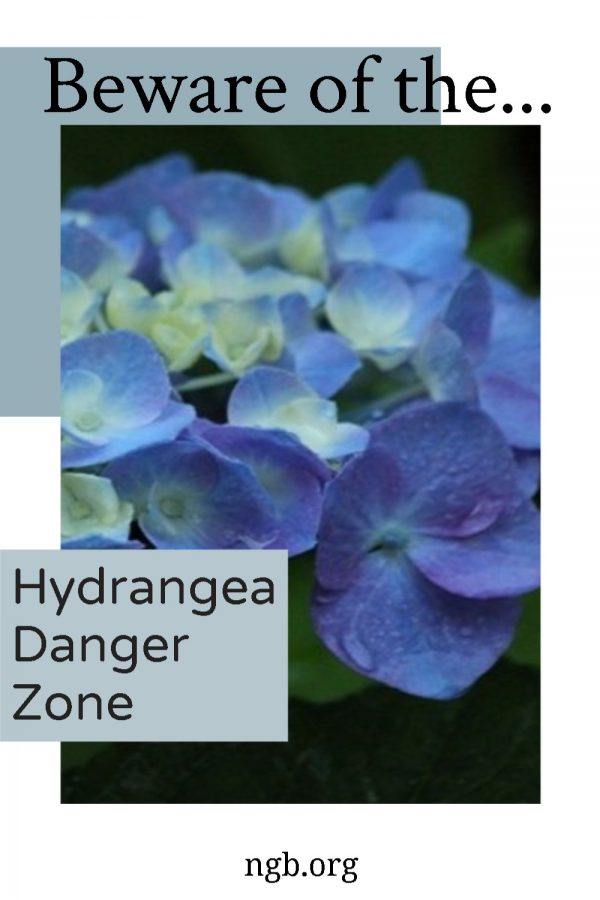What is the Hydrangea Danger Zone™?
Right now you and all other gardeners who grow hydrangeas could be in the Hydrangea Danger Zone. It’s that time between the fall when your “old wood” hydrangeas set their flower buds, and the coming spring when those buds emerge. That is if they have made it through the winter.
But what makes it so dangerous, you may ask. We, the gardeners! We want to get outside at the first sign of warm weather and start pruning our plants. Therein lies the problem. If you cut your old wood hydrangeas now before you see those new buds, you could actually unwittingly remove those buds. Then all you will have is a nice green bush – Mon dieu!
The Key is to Know Which Hydrangeas Flower on Old Wood
So you need to figure out which of your hydrangeas flower on old wood. Those are the stems that have the flower buds you want to protect from pruning cuts. I can help you with that.
If your flowers are cone-shaped and change color from white or cream to shades of pink and rose, and the leaves look like an oak leaf, that’s an oak leaf hydrangea (quercifolia). Oakleaf hydrangeas always flower on old wood.
If you’re lucky enough to have a hydrangea that’s a vine, that’s a climbing hydrangea (anomala petiolaris)
which also flowers on old wood.
If your flowers are round and blue, that’s a big leaf hydrangea (macrophylla), an old wood flowering plant or a mountain hydrangea (serrata).
Those flowers can also be somewhat flat and even lacey-looking. This lacecap flower can be on your big leaf (macrophylla) or your mountain hydrangeas (serrata). Lacecap flowers can come on plants that flower on old wood.
But what if you have a plant with round flowers that are white and don’t change color? That’s also a big leaf (macrophylla) hydrangea.
The last option you may have is a hydrangea with pink flowers that you can sometimes change to blue. But that’s a tricky one since it can be confused with another similar-looking one that doesn’t change to blue. If it doesn’t change to blue and stays some shade of cream or pink, it could be a woodland/smooth hydrangea (arborescens) like ‘Annabelle.’ The foliage will confirm which it is so check it out to be sure.
Exactly What You CAN Cut Now
Any of your purely new wood bloomers can be cut and trimmed now. That means you can take care of your panicle and woodland plants. No worries since their flowers this year will come from the growth they put on in the spring. In fact, pruning cuts can stimulate them to produce more flowers.
What Plants Should I Leave Alone?
Leave your oakleaf and climbing hydrangeas alone unless you have dead, diseased, or damaged wood that needs to be removed.
Try your best to leave your big leaf and mountain hydrangeas alone as well. Those old wood flowers will start to show their buds soon. The best thing you can do is wait for your plant to break dormancy. Then inspect it for those tiny little buds called “broccoli”.
If your plant has outgrown its allotted space and you don’t care about losing flowers, then cut away. I would personally prefer to first get the flowers this season and then cut it back before August 1.
Do I Treat Rebloomers Differently?
We already know that reblooming big leaf hydrangeas can flower on new wood, but don’t think that rebloomers flower ONLY on new wood. Au contraire, rebloomers have both old and new wood genetics. And those old wood buds are waiting to come out and play. They, therefore, need to be protected from premature pruning.
If it’s a rebloomer, it’s even safer to wait until you have passed your last frost-free date. That’s because
rebloomers can give you a second season of flowers as long as those sleeping buds haven’t awakened. Sometimes when we cut before that last frost-free date, the reblooming buds start swelling as spring temps warm-up. Then they get zapped by a late-season weather event like snow or ice. I speak from experience.
The Wisdom of Doing Nothing
You are left with a couple of options for big leaf and mountain hydrangeas: do nothing which is fine and more than acceptable. Or you can wait to see those buds and do everything you can to protect them if ol’ man winter comes back one more time.
If I Can’t Prune, Exactly What Else Can I Do?
Scratch that gardening itch by cleaning up your gardening tools and sharpening your pruners. Not only will you feel holy but you’ll be ready for the right time when you can confidently cut your old wood plants safely.
Now, do you see why I call it the Hydrangea Danger Zone?
Learn more about Hydrangeas at…
“This post is provided as an educational/inspirational service of the National Garden Bureau and our members. Please credit and link to National Garden Bureau and author member when using all or parts of this article.”








